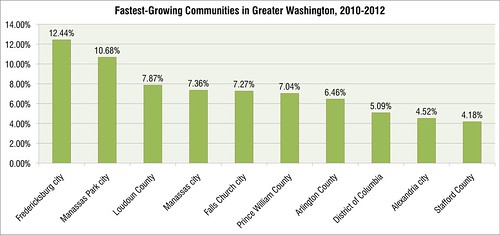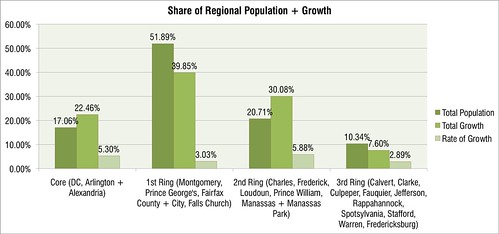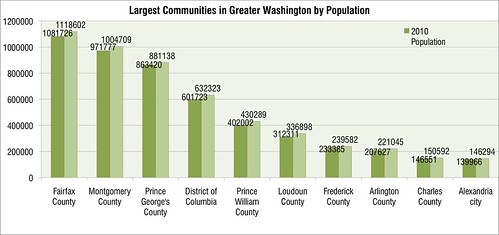 |
| Who has two thumbs and lives in a place with 1 million people? You. You are that person. |
After years of rapid population growth, Greater Washington might be slowing down. However, the real story is where most regional growth is happening: not on the suburban fringe, but in and around the Beltway. As a result, Montgomery County has now topped 1 million residents.
Yesterday, the Census Bureau released their population estimates for the region, which is defined as the District and 27 surrounding counties and independent cities in Maryland, Virginia and West Virginia. While the Washington Post focused on slightly slower population growth than in previous years, there are much more interesting trends occurring.
Regional growth still among the highest in the nation
The Census Bureau estimates that the Washington-Arlington-Alexandria Metropolitan Statistical Area, which is what they call Greater Washington, had just over 5.8 million residents in 2012. If you include Greater Baltimore, our combined region has 8.6 million people, making it the fourth-largest metropolitan area in the country, behind New York, Los Angeles and Chicago.
Greater Washington added 89,000 new residents between July 2011 and July 2012, which the Post notes is fewer people than we added the year before. It calls this the "twilight hour of a remarkable phase in the Washington region" during which Americans flocked to the area in search of jobs, adding to the area's population. Yet we've still had the fifth-largest increase in population of any metropolitan area in the country. We added more people than traditionally fast-growing Sunbelt cities like Atlanta and Phoenix.
Inside-the-Beltway communities among the nation's fastest-growing
 |
| The ten fastest-growing communities in the DC area. Four of them are inside the Beltway. |
The District now has 632,000 residents, about what it had during the 1980's. For the first time ever, Washington now has more people than Baltimore City, which has also started gaining residents for the first time in decades.
Joining the District on the list are several jurisdictions in Northern Virginia, including Arlington and Loudoun counties and the cities of Alexandria, Falls Church and Fredericksburg, which grew at a rate of 12.44% between 2010 and 2012, making it the region's fastest growing community.
Places like Loudoun are no stranger to the list of fastest-growing counties, having transitioned from farms to suburbia in less than a generation. However, the addition of inside-the-Beltway communities like Arlington and Alexandria is impressive. DC, Arlington and Alexandria have all sought to encourage smart infill development around Metro as a way to revitalize older neighborhoods, and it's clear they've been really successful.
Meanwhile, first-ring suburban counties haven't been slouching. Between 2010 and 2012, Montgomery and Fairfax counties grew by 3.39% and 3.41%, respectively, just below the region's average of 3.98%. In 2012, Montgomery's population reached 1 million for the first time, making it and Fairfax the only jurisdictions in the region with a 7-figure population. The county now has 1,004,709 residents.
Majority of region's growth happening in and around the core
 |
| First-ring counties like Montgomery County have the region's largest share of residents and accept the largest share of its growth. |
Not only are the core and inner-ring suburban counties continuing to grow, but they're carrying most of the region's growth. Of the 224,000 people who moved to Greater Washington between 2010 and 2012, 62% of them moved to the city and inner suburbs. As a result, the core and inner ring now contain 69% of the region's total population.
Roughly 1 in 7 new residents moved to the District of Columbia, while 22% moved to either DC, Arlington or Alexandria. Though the inner suburban counties, Montgomery, Prince George's and Fairfax, are growing at a slower rate than both the core and "second-ring" counties like Loudoun and Prince William, they received about 40% of the region's population growth. Another 30% occurred in the second-ring counties, while 7% went to rural counties in Maryland, Northern Virginia and West Virginia.
We don't have any data for where growth is specifically occurring in the inner ring, but judging from the building boom in places like Silver Spring in Montgomery and Merrifield in Fairfax, it's likely happening in the same kinds of places and for the same reasons as in the District, Arlington and Alexandria.
Growth is occurring unevenly
 |
| The 10 largest communities in Greater Washington by population. Montgomery County is #2. |
While most close-in communities are growing at a fast clip, Prince George's County isn't doing as well. It grew at a rate of just 2% between 2010 and 2012, placing it among the region's slowest-growing counties. This is not only unfortunate for Prince George's, which for decades has lagged neighboring counties in drawing people and businesses, but for the region as a whole.
DC's resurgence and the continued growth of older suburban counties like Montgomery suggest that people want to live close in. Presumably, Prince George's should benefit from that demand, but for a variety of reasons it's being directed to further-out areas, which results in more traffic, more destruction of natural or agricultural land, and the ongoing disinvestment of older neighborhoods. Directing more investment to Prince George's should be a regional priority, as it will further add to the strength of other communities around the Beltway.
Yes, Greater Washington is growing a little more slowly than it used to, and that's okay. The big news is that unlike many metropolitan areas in the United States, we're growing at the center, not at the fringe. Not only does it make our region stronger and more sustainable, but it shows that other places around the country don't have to accept unending suburban sprawl as a given.

No comments:
Post a Comment